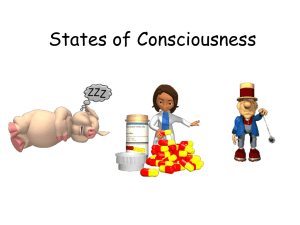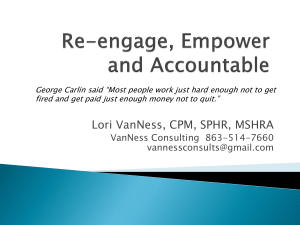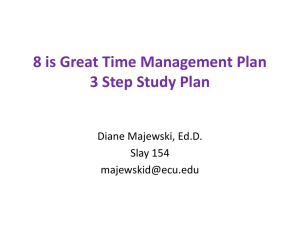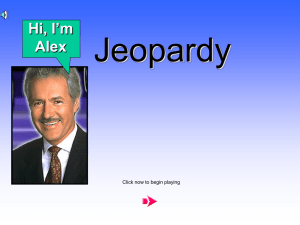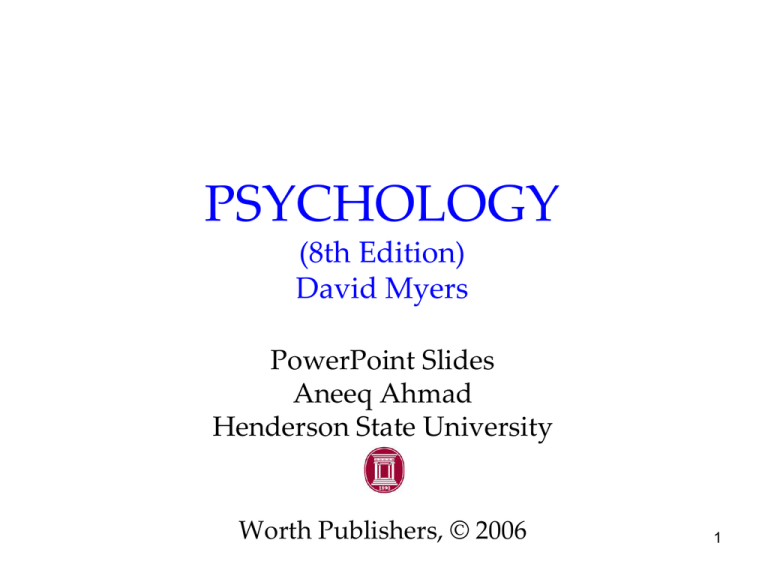
PSYCHOLOGY
(8th Edition)
David Myers
PowerPoint Slides
Aneeq Ahmad
Henderson State University
Worth Publishers, © 2006
1
States of
Consciousness
Chapter 7
2
States of Consciousness
Consciousness and
Information Processing
Sleep and Dreams
Biological Rhythms
The Rhythm of Sleep
Sleep Disorders
Dreams
3
States of Consciousness
Hypnosis
Facts and Falsehoods
Is Hypnosis an Altered State of
Consciousness?
Drugs and Consciousness
Dependence and Addiction
Psychoactive Drugs
Influences on Drug Use
4
States of Consciousness
Near-Death Experiences
5
History of Consciousness
1. Psychology began as a science of
consciousness.
2. Behaviorists argued about alienating
consciousness from psychology.
3. However, after 1960, mental concepts
(consciousness) started reentering
psychology.
6
Waking Consciousness
• Behaviorism’s rejection of
consciousness- by 1960,
study of consciousness
abandoned due to
behaviorism wanting to only
study observable events.
• In comparison with
unconscious processing,
conscious processing has
limited capacity, is relatively
slow, and processes pieces of
information serially.
• Study of consciousness
nearly- LOST
7
Characteristics and Benefits of
Daydreams
•
•
•
•
•
•
•
Occurs in private world
Begins spontaneously
Triggered by internal or external stimuli
or cues (Klinger, 1990)
Deals most often with life concerns
Lack of self-awareness
Dissociation from waking
Benefits
– puts one in a positive orientation
– Avoids negative emotional tone
– Keeps Mind active
– Might even keep up with lack of REM
that diminishes in adulthood.
8
Neuroscience & Consciousness
Neuroscientists believe that consciousness
emerges from the interaction of individual
brain events much like a chord that is created
from different musical notes.
9
Forms of Consciousness
AP Photo/ Ricardo Mazalan
Stuart Franklin/ Magnum Photos
Christine Brune
Bill Ling/ Digital Vision/ Getty Images
Consciousness, modern psychologists believe, is
an awareness of ourselves and our environment.
10
Consciousness & Information
Processing
The unconscious mind processes information
simultaneously on multiple tracks, while the conscious
mind processes information sequentially.
Conscious mind
Unconscious mind
11
Sleep & Dreams
Sleep – the irresistible tempter to whom we
inevitably succumb.
Mysteries about sleep and dreams have just started
unraveling in sleep laboratories around the world.
12
Biological Rhythms
Biological rhythms are controlled by
internal “biological clocks.”
1. Annual cycles: On an annual cycle, geese
migrate, grizzly bears hibernate, and humans
experience seasonal variations in appetite,
sleep, and mood. Seasonal Affective Disorder
(SAD) is a mood disorder people experience
during dark winter months.
13
Biological Rhythms
2. 28-day cycles: The
female menstrual
cycle averages 28
days. Research
shows menstruation
may not affect
moods.
14
Biological Rhythms
3. 24-hour cycles: Humans experience 24-hour
cycles of varying alertness (sleep), body
temperature, and growth hormone secretion.
4. 90-minute cycles: We go through various stages
of sleep in 90-minute cycles.
15
Rhythm of Sleep
Illustration © Cynthia Turner 2003
Circadian Rhythms occur on a 24-hour cycle and
include sleep and wakefulness, which are
disrupted during transcontinental flights (jetlag).
Lark- morning person; Owl- Night person; Light triggers
the suprachiasmatic nucleus to decrease
(morning) melatonin from the pineal gland
and increase (evening) it at night fall.
Shift work- light interrupts 24 hour clock; Phase delay
Shift- we are on a 25 hour clock due to how late we stay
up. ( people your age are larks)
16
Sleep Stages
Measuring sleep: About every 90 minutes, we
pass through a cycle of five distinct sleep stages.
Hank Morgan/ Rainbow
17
Awake & Alert
During strong mental engagement, the brain
exhibits low amplitude and fast, irregular beta
waves (15-30 cps). An awake person involved in a
conversation shows beta activity.
Beta Waves
18
Awake but Relaxed
When an individual closes his eyes but remains
awake, his brain activity slows down to a large
amplitude and slow, regular alpha waves (9-14
cps). A meditating person exhibits an alpha brain
activity.
19
Characteristics of Sleep Stages
•
•
•
•
Stage 1- hallucinations- false
sensory experiences such as
seeing something in the
absence of external visual
stimulus; hypnagogic
sensations- falling, floating
weightlessly
Stage 2- sleep spindlesbursts of rapid rhythmic brain
wave activity; sleep talking
Stage 3/4- slow wave sleep,
delta waves, sleep walking,
bedwetting
REM sleep- paradoxical sleep,
dreams
20
Sleep Stages 1-2
During early, light sleep (stages 1-2) the brain
enters a high-amplitude, slow, regular wave form
called theta waves (5-8 cps). A person who is
daydreaming shows theta activity.
Theta Waves
21
Sleep Stages 3-4
During deepest sleep (stages 3-4), brain activity
slows down. There are large-amplitude, slow
delta waves (1.5-4 cps).
22
Stage 5: REM Sleep
After reaching the deepest sleep stage (4), the
sleep cycle starts moving backward towards stage
1. Although still asleep, the brain engages in lowamplitude, fast and regular beta waves (15-40 cps)
much like awake-aroused state.
A person during this sleep exhibits
Rapid Eye Movements (REM)
and reports vivid dreams.
23
90-Minute Cycles During Sleep
With each 90-minute cycle, stage 4 sleep decreases
and the duration of REM sleep increases.
24
Why do we Sleep- Age
Differences?
•
•
•
•
Newborns spend nearly 2/3 of
their day asleep, while adults
spend no more than 1/3
Sleep patterns are influenced by
genes, as indicated by the fact
that sleep patterns among
identical twins are similar. Sleep is
also influenced by culture.
Allowed to sleep unhindered, most
people will sleep 9 hours a night.
Teenagers typically need 9 hours
of sleep but now average nearly 2
hours less sleep than teenagers of
80 years ago
25
Negative Effects
•
William Dement believes the majority
are dangerously sleep deprived. One
effect of this state is promote weight
gain by increasing the hormone
ghrelin and decreasing the hormone
leptin. Another is that sleep
deprivation may suppress the
functioning of the body’s immune
system and alter metabolic and
hormonal functioning in ways that
mimic aging and are conducive to
hypertension and memory
impairment. Another indication of
hazards of this state is the rate of
accidents tends to increase
immediately after the spring time
change in Canada and the US.
26
Why do we sleep?
We spend one-third of
our lives sleeping.
Jose Luis Pelaez, Inc./ Corbis
If an individual
remains awake for
several days, they
deteriorate in terms of
immune function,
concentration, and
accidents.
27
Sleep Deprivation
1. Fatigue and subsequent death.
2. Impaired concentration.
3. Emotional irritability.
4. Depressed immune system.
5. Greater vulnerability.
28
Accidents
Frequency of accidents increase with loss of sleep
29
Sleep Theories
1. Sleep Protects: Sleeping in the darkness when
predators loomed about kept our ancestors out
of harm’s way.
2. Sleep Recuperates: Sleep helps restore and
repair brain tissue.
3. Sleep Helps Remembering: Sleep restores and
rebuilds our fading memories.
4. Sleep and Growth: During sleep, the pituitary
gland releases growth hormone. Older people
release less of this hormone and sleep less.
30
Major Sleep Disorders
•
•
A persistent difficulty in falling or
staying asleep is characteristic of
insomnia. Sleeping pills and
alcohol may make the problem
worse since they tend to reduce
REM sleep.
The sleep disorder in which a
person experiences uncontrollable
sleep attacks is narcolepsy. People
with severe cases of this disorder
may collapse directly into REM
sleep and experience a loss of
muscular tension. This disorder
may be linked to low levels of the
neurotransmitter orexin, which is
linked to alertness.
31
Major Sleep Disorders
• Individuals suffering from sleep
apnea stop breathing while
sleeping. This disorder is
especially prevalent among
overweight men.
• Night Terrors- extreme fright,
rapid breathing; early in night
during stage 4. Same is true of
episodes of sleepwalking and
sleeptalking, problems that run
in families. Happens to young
children in whom this stage
tends to be the lengthiest and
deepest.
32
5 Perspectives on Why we
Dream?
•
•
•
•
Lucid Dreams- dreams
experienced during REM sleep
are vivid, emotional, and bizarre.
Manifest Dreams- actual content
of dream
Latent Content- symbolic version
of true meaning of dream
in Freud's view, were all forms of
"wish-fulfillment" — attempts by
the unconscious to resolve a
conflict of some sort, whether
something recent or something
from the recesses of the past
33
5 Perspectives on Why we
Dream?
•
•
•
•
•
Information Processing- REM sleep
facilitates memory- Brain scans show link
between REM and memory
Physiological Functioning- REM provides
brain with stimulation. Supported by infants
spending time in REM sleep
Activation Synthesis- says dreams are the
burst’s attempt to make sense of this
activity. Bursts are believed to be given their
emotional tone by the limbic system.
All researchers agree we need REM sleepDeprivation causes REM reboundREM sleep does occur in other mammals.
Animals such as fish, whose behavior is less
influenced by learning do not dream. Finding
supports the information processing theory
of dreaming.
34
Hypnosis
•
•
•
•
•
Hypnosis is a social interaction in
which a hyponist suggests that a
subject will experience certain feelings
or thoughts for example.
Most people are somewhat
hypnotically suggestible.
The idea that we can relive childhood
experiences through hypnosisreferred to as age regression- has
been supported by research.
Research studies show that
hypnotically refreshed memories
combine fact with fiction.
An authority figure in a legitimate
context can induce people- hypnotized
or not- to perform unlikely acts.
35
Hypnosis
•
•
•
•
Posthypnotic suggestion- helps people
alleviate headaches, asthma, stress
related skin disorders
Hypnosis- works on treatment of
obesity, but not drug and alcohol,
DOES alleviates pain
Skeptics believe that hypnosis may
reflect the workings of normal
consciousness. This helps support the
social influence theory of hypnosis.
Hilgard has advanced the idea of a
dissociation, or split, between different
levels of consciousness. He believes
there is a spilt between sensory and
emotional aspects of pain.
36
Sleep Disorders: Insomnia
1. Somnambulism: Sleepwalking.
2. Nightmares: Frightening dreams that wake
a sleeper from REM.
3. Night terrors: Sudden arousal from sleep
with intense fear accompanied by
physiological reactions (e.g., rapid heart
rate, perspiration) that occur during SWS.
37
Sleep Disorders: Insomnia
4. Narcolepsy: Overpowering urge to fall
asleep that may occur while talking or
standing up.
5. Sleep apnea: Failure to breathe when
asleep.
38
Dreams
The link between REM
sleep and dreaming
has opened up a new
era of dream research.
39
What do we Dream?
1. Negative Emotional Content: 8 out of 10
dreams have negative emotional content such
as fears of being attacked.
2. Failure Dreams: People commonly dream
about failure, being attacked, pursued,
rejected, or struck with misfortune.
3. Sexual Dreams: Contrary to our thinking,
sexual dreams are sparse. Sexual dreams in
men are 1 in 10; and in women 1 in 30.
4. Dreams of Gender: Women dream of men
and women equally; men dream more about
men than women.
40
Why do we dream?
1. Wish Fulfillment: Sigmund Freud suggested
that dreams provide a psychic safety valve to
discharge unacceptable feelings. The dream’s
manifest (apparent) content may also have
symbolic meanings (latent content) that signify
our unacceptable feelings.
2. Information Processing: Dreams may help sift,
sort, and fix a day’s experiences in our
memories.
41
Why do we dream?
3. Physiological
Function: Dreams
provide the sleeping
brain with periodic
stimulation to
develop and preserve
neural pathways.
Neural networks of
newborns are quickly
developing; therefore,
they need more sleep.
42
Why do we dream?
4. Activation-Synthesis Theory: Suggests that the
brain engages in a lot of random neural
activity. Dreams make sense of this activity.
5. Cognitive Development: Some researchers
argue that we dream as a part of brain
maturation and cognitive development.
All dream researchers believe we need REM sleep. When
deprived of REM sleep and then allowed to sleep,
we show increased REM sleep called REM Rebound.
43
Dream Theories
Summary- KNOW THIS CHART
44
Hypnosis
http://iddiokrysto.blog.excite.it
A social interaction in
which one person (the
hypnotist) suggests to
another (the subject)
that certain
perceptions, feelings,
thoughts, or behaviors
will spontaneously
occur.
Hypnos: Greek god of sleep
45
Mesmerism
http://www.general-anaesthesia.com
Credit for the popularity
of hypnosis goes to
Franz Anton Mesmer, a
physician, who
mistakenly thought he
discovered “animal
magnetism.” Some of his
patients experienced a
trancelike state and felt
better upon waking up.
Franz Mesmer (1734 - 1815)
46
Aspects of Hypnosis
1. Posthypnotic Suggestion: Suggestion carried
out after the subject is no longer hypnotized.
2. Posthypnotic Amnesia: Supposed inability to
recall what one experienced during hypnosis.
47
Hypnotic Feats
Strength, stamina, and perceptual and memory
abilities similarly affect those who are
hypnotized and those who are not
hypnotized.
48
Facts and Falsehood
Those who practice hypnosis agree that its power
resides in the subject’s openness to suggestion.
Can anyone experience hypnosis?
Yes, to some extent.
Can hypnosis enhance recall of
forgotten events?
No.
49
Facts and Falsehood
Can hypnosis force people to act
against their will?
No.
Can hypnosis be therapeutic?
Yes. Self-suggestion
can heal too.
Can hypnosis alleviate pain?
Yes. Lamaze can
do that too.
50
Is Hypnosis an Altered State of
Consciousness?
Courtesy of News and Publications Service, Stanford University
1. Social Influence Theory:
Hypnotic subjects may
simply be imaginative
actors playing a social
role.
2. Divided Consciousness
Theory: Hypnosis is a
special state of
dissociated (divided)
consciousness (Hilgard,
1986, 1992).
(Hilgard, 1992)
51
Mimi Forsyth
Both Theories
52
Drugs and Consciousness
Psychoactive Drug: A chemical substance that
alters perceptions and mood (effects
consciousness).
53
Dependence & Addiction
Continued use of a
psychoactive drug
produces tolerance.
With repeated
exposure to a drug,
the drug’s effect
lessens. Thus it takes
greater quantities to
get the desired effect.
54
Withdrawal & Dependence
1. Withdrawal: Upon stopping use of a drug
(after addiction), users may experience the
undesirable effects of withdrawal.
2. Dependence: Absence of a drug may lead to a
feeling of physical pain, intense cravings
(physical dependence), and negative emotions
(psychological dependence).
55
Misconceptions about Addiction
Addiction is a craving for a chemical substance,
despite its adverse consequences (physical &
psychological).
1. Addictive drugs quickly corrupt.
2. Addiction cannot be overcome voluntarily.
3. Addiction is no different than repetitive
pleasure-seeking behaviors.
56
Psychoactive Drugs
Psychoactive drugs are divided into three groups.
1. Depressants
2. Stimulants
3. Hallucinogens
57
Depressants
Depressants are drugs that reduce neural activity
and slow body functions. They include:
1. Alcohol
2. Barbiturates
3. Opiates
58
Alcohol
1. Alcohol affects motor skills, judgment, and
memory…and increases aggressiveness while
reducing self awareness.
Ray Ng/ Time & Life Pictures/ Getty Images
Daniel Hommer, NIAAA, NIH, HHS
Drinking and Driving
59
Barbiturates
2. Barbiturates: Drugs that depress the activity of
the central nervous system, reducing anxiety
but impairing memory and judgment.
Nembutal, Seconal, and Amytal are some
examples.
60
Depressants
http://opioids.com/timeline
3. Opiates: Opium and its
derivatives (morphine
and heroin) depress
neural activity,
temporarily lessening
pain and anxiety. They
are highly addictive.
61
Stimulants
Stimulants are drugs that excite neural activity and
speed up body functions.
1.
2.
3.
4.
5.
6.
Caffeine
Nicotine
Cocaine
Ecstasy
Amphetamines
Methamphetamines
62
Caffeine & Nicotine
Caffeine and nicotine increase heart and
breathing rates and other autonomic functions to
provide energy.
http://office.microsoft.com/clipart
http://www.tech-res-intl.com
63
Amphetamines
Amphetamines stimulate neural activity, causing
accelerated body functions and associated energy
and mood changes, with devastating effects.
National Pictures/ Topham/ The Image Works
64
Ecstasy
Greg Smith/ AP Photos
Ecstasy or
Methylenedioxymethamphet
amine (MDMA) is a
stimulant and mild
hallucinogen. It produces a
euphoric high and can
damage serotonin-producing
neurons, which results in a
permanent deflation of mood
and impairment of memory.
65
Cocaine
Cocaine induces immediate euphoria followed by a crash.
Crack, a form of cocaine, can be smoked. Other forms of
cocaine can be sniffed or injected.
http://www.ohsinc.com
66
Hallucinogens
Ronald K. Siegel
Hallucinogens are
psychedelic (mindmanifesting) drugs that
distort perceptions and
evoke sensory images in
the absence of sensory
input.
67
Hallucinogens
Hemp Plant
http://static.howstuffworks.com
1. LSD: (lysergic acid diethylamide) powerful
hallucinogenic drug (ergot fungus) that is
also known as acid.
2. THC (delta-9-tetrahydrocannabinol): is the
major active ingredient in marijuana (hemp
plant) that triggers a variety of effects,
including mild hallucinations.
68
Drugs
Summary- KNOW CHART
69
Influences on Drug Use
The graph below shows the percentage of US highschool seniors reporting their use of alcohol,
marijuana, and cocaine from the 70s to the late 90s.
70
Influences on Drug Use
The use of drugs is based on biological,
psychological, and social-cultural influences.
71
Marijuana Use
The use of marijuana in teenagers is directly related
to the “perceived risk” involved with the drug.
72
Near-Death Experiences
(From “Hallucinations” by R.K. Siegel. Copyright
© 1977 Scientific American, Inc. All rights reserved.)
After a close brush with
death, many people
report an experience of
moving through a dark
tunnel with a light at the
end. Under the influence
of hallucinogens, others
report bright lights at
the center of their field
of vision.
73
Mind-Body Problem
Near-death experiences raise the mind-body issue.
Can the mind survive the dying body?
1. Dualism: Dualists believe that mind (nonphysical) and body (physical) are two distinct
entities that interact.
2. Monism: Monists believe that mind and body
are different aspects of the same thing.
74
Stress and Health
Chapter 14
75
Stress and Health
Stress and Illness
Stress and Stressors
Stress and the Heart
Stress and the Susceptibility to
Disease
Promoting Health
Coping with Stress
76
Stress and Health
Promoting Health
Managing Stress
Modifying Illness-Related
Behaviors
Thinking Critically About:
Alternative Medicine – New
Ways to Health, or Cold Snake
Oil
77
Stress
Psychological states cause physical illness. Stress
is any circumstance (real or perceived) that
threatens a person’s well-being.
Lee Stone/ Corbis
When we feel severe stress, our ability to cope with it is impaired.
78
Stress and Causes of Death
Prolonged stress combined with unhealthy
behaviors may increase our risk for one of
today's four leading diseases.
79
Behavioral Medicine
Centers for Disease Control (CDC) claim that half
of the deaths in the US are due to people’s
behaviors (smoking, alcoholism, unprotected sex,
insufficient exercise, drugs, and poor nutrition).
Psychologists and physicians have thus
developed an interdisciplinary field of behavioral
medicine that integrates behavioral knowledge
with medical knowledge.
80
Health Psychology
Health psychology is a field of psychology that
contributes to behavioral medicine. The field
studies stress-related aspects of disease and asks
the following questions:
1.
2.
3.
4.
How do emotions and personality factors influence the risk of
disease?
What attitudes and behaviors prevent illness and promote
health and well-being?
How do our perceptions determine stress?
How can we reduce or control stress?
81
Stress and Illness
Stress can be adaptive. In a fearful
or stress- causing situation, we can
run away and save our lives. Stress
can be maladaptive. If it is
prolonged (chronic stress), it
increases our risk of illness and
health problems. Example for youStressor- final exam; stress reactionemotional response to the exam;
Thus, stress is not merely a
stimulus or a response. Rather, it is
the process we cope with
environmental threats and
challenges
82
Stress and Stressors
Stress is a slippery concept. At times it is the
stimulus (missing an appointment) and at other
times it is a response (sweating while taking a
test).
83
Stress and Stressors
Stress is not merely a stimulus or a response. It is
a process by which we appraise and cope with
environmental threats and challenges.
Bob Daemmrich/ The Image Works
When short-lived or taken as a challenge, stressors may have positive effects.
However, if stress is threatening or prolonged, it can be harmful.
84
The Stress Response System
Canon proposed that
the stress response
(fast) was a fight-orflight response
marked by the
outpouring of
epinephrine and
norepinephrine from the
inner adrenal glands,
increasing heart and
respiration rates,
mobilizing sugar and
fat, and dulling pain.
85
The Stress Response System
The hypothalamus and
the pituitary gland also
respond to stress (slow)
by triggering the outer
adrenal glands to
secrete glucocorticoids
(cortisol).
86
Stress Response between Men
and Woman
• Men socially withdraw, turn
to alcohol, or become
aggressive while women
seek and give support called
tend and befriend. This is
due to oxytoxin, a stress
moderating hormone
associated with pair bonding
in animals and released by
cuddling, massage, and
breastfeeding in humans
87
General Adaptation Syndrome
EPA/ Yuri Kochetkov/ Landov
According to Selye, a stress response to any kind of
stimulation is similar. The stressed individual goes
through three phases.
88
Stressful Life Events
Catastrophic Events:
Catastrophic events like
earthquakes, combat
stress, and floods lead
individuals to develop
psychological disorders
such as being
depressed, sleepless,
and anxious.
89
Significant Life Changes
The death of a loved one, a divorce, a loss of job,
or a promotion may leave individuals vulnerable
to disease.
90
Daily Hassles
Rush hour traffic, long lines,
job stress, and becoming burntout are the most significant
sources of stress and can
damage health. The stresses
that accompany poverty and
unemployment, for example,
are often compounded by
racism, may account for the
higher rates of hypertension
among residents of
impoverished areas
91
Stress and the Heart
Stress that leads to elevated blood pressure may
result in Coronary Heart Disease, a clogging of
the vessels that nourish the heart muscle. Occurs
due to smoking, obesity, physical inactivity, high
fat diet, high cholesterol
Plaque in
coronary artery
Artery
clogged
92
Personality Types
Type A is a term used for competitive, harddriving, impatient, verbally aggressive, and
anger-prone people. Type B refers to easygoing,
relaxed people (Friedman and Rosenman, 1974)
Also showed tax accountants show increases in
blood cholesterol. Shows link between coronary
warning and stress.
Type A personalities are more likely to develop
.
coronary heart disease.
93
Pessimism and Heart Disease
Pessimistic adult men are twice as likely to
develop heart disease over a 10-year period
(Kubzansky et al., 2001).
94
Stress & Susceptibility to Disease
A psychophysical illness is any stress-related
physical illness such as hypertension or
headaches. Hypochondriasis is a
misinterpretation of normal physical sensations
as symptoms of disease.
95
Stress and the Immune System
B lymphocytes fight bacterial infections, T
lymphocytes attack cancer cells and viruses, and
microphages ingest foreign substances. During
stress, energy is mobilized away from the
immune system making it vulnerable.
Lennart Nilsson/ Boehringer Ingelhein International GmbH
96
Stress and Colds
People with the highest life stress scores were also
the most vulnerable when exposed to an
experimental cold virus.
97
Stress and AIDS
Stress and negative emotions may accelerate the
progression from human immunodeficiency virus
(HIV) to acquired immune deficiency syndrome
(AIDS).
UNAIDS/ G. Pirozzi
98
Stress and Cancer
Stress does not create cancer cells. Researchers
disagree on whether stress influences the
progression of cancer. However, they do agree
that avoiding stress and having a hopeful attitude
cannot reverse advanced cancer.
99
Stress and Immune Conditioning
If the immune system can be suppressed through
conditioning, researchers believe that immuneenhancing responses can be inculcated to combat
viral diseases.
100
Health-Related Consequences
Kathleen Finlay/ Masterfile
Stress can have a variety of health-related
consequences.
101
Promoting Health
Promoting health is generally defined as the
absence of disease. We only think of health
when we are diseased. However, health
psychologists say that promoting health begins
by preventing illness and enhancing well-being,
which is a constant endeavor.
102
Coping with Stress
Reducing stress by changing events that cause
stress or by changing how we react to stress is
called problem-focused coping.
Emotion-focused coping is when we cannot
change a stressful situation, and we respond by
attending to our own emotional needs.
103
Perceived Control
Research with rats and humans indicates that
the absence of control over stressors is a
predictor of health problems.
104
Explanatory Style
People with an optimistic (instead of
pessimistic) explanatory style tend to have more
control over stressors, cope better with stressful
events, have better moods, and have a stronger
immune system.
105
Social Support
Bob Daemmrich/ Stock, Boston
Supportive family members, marriage partners,
and close friends help people cope with stress.
Their immune functioning calms the
cardiovascular system and lowers blood pressure.
106
Managing Stress
Having a sense of control, an optimistic
explanatory style, and social support can reduce
stress and improve health.
107
Aerobic Exercise
Can aerobic exercise
boost spirits? Many
studies suggest that
aerobic exercise can
elevate mood and wellbeing because aerobic
exercise raises energy,
increases selfconfidence, and lowers
tension, depression, and
anxiety.
108
Biofeedback, Relaxation, and
Meditation
Biofeedback systems use
electronic devices to
inform people about their
physiological responses
and gives them the chance
to bring their response to a
healthier range.
Relaxation and meditation
have similar effects in
reducing tension and
anxiety.
109
Life-Style
Ghislain and Marie David De Lossy/ Getty Images
Modifying a Type-A lifestyle may reduce the
recurrence of heart attacks.
110
Spirituality & Faith Communities
Regular religious attendance has been a reliable
predictor of a longer life span with a reduced
risk of dying.
111
Intervening Factors
Investigators suggest there are three factors that
connect religious involvement and better health.
112
Managing Stress: Summary
How can stress be managed?
113
Modifying Illness-Related Behaviors
The elimination of smoking would increase life
expectancy more than any other preventive
measure.
114
Why Do People Smoke?
1. People smoke because it is socially rewarding.
2. Smoking is also a result of genetic factors.
Russel Einhorn/ The Gamma Liason Network
115
Why Do People Smoke?
3.
4.
Nicotine takes away unpleasant
cravings (negative reinforcement)
by triggering epinephrine,
norepinephrine, dopamine, and
endorphins.
Nicotine itself is rewarding
(positive reinforcement).
116
Biopsychosocial Factors: Smoking
117
Helping Smokers Quit
Smoking decreased in Western countries,
especially in higher socioeconomic groups and
more educated groups.
118
Ways to Quit Smoking
Here are a few pointers on how to quit smoking:
1.
2.
3.
4.
5.
6.
7.
Set a quit date.
Inform family and friends.
Throw away all cigarettes.
Review successful strategies.
Use a nicotine patch or gum.
Abstain from alcohol.
Exercise.
119
Smoking Abstinence Programs
Smoking abstinence programs for teens provide:
1.
2.
3.
Information about the effects of smoking
Information about peer, parent & media influence
Ways to refuse cigarettes
120
Do Programs Work?
Paul J. Milette/ Palm Beach Post
Prevention programs do have an effect on
smoking.
121
Obesity and Weight Control
Fat is an ideal form of
stored energy and is
readily available. In
times of famine, an
overweight body was
a sign of affluence.
122
Body Mass Index (BMI)
Obesity in children
increases their risk of
diabetes, high blood
pressure, heart
disease, gallstones,
arthritis, and certain
types of cancer, thus
shortening their lifeexpectancy.
123
Obesity and Mortality
The death rate is high among very overweight
men.
124
Social Effects of Obesity
When women applicants were made to look
overweight, subjects were less willing to hire
them.
125
Physiology of Obesity
Fat Cells: There are 30-40 million fat cells in the
body. These cells can increase in size or increase
in number (75 million) in an obese individual
(Sjöstrum, 1980).
126
Set Points and Metabolism
When reduced from 3,500 calories to 450 calories,
weight loss was a minimal 6% and the metabolic
rate a mere 15%.
The obese defend their weight by conserving energy.
127
The Genetic Factor
Identical twin studies reveal that body weight has
a genetic basis.
Courtesy of John Soltis, The Rockefeller University, New York, NY
The obese mouse on the left has a defective gene for the hormone leptin. The mouse on
the right sheds 40% of its weight when injected with leptin.
128
Activity
Lack of exercise is a major contributor to obesity.
Just watching TV for two hours resulted in a 23%
increase of weight when other factors were
controlled (Hu et al., 2003).
129
Food Consumption
Over the past 40 years average weight gain has
increased. Health professionals are pleading with
US citizens to limit their food intake.
130
Trading Risks
Although cigarette smoking has declined over
the years in the Americas, obesity is on the rise.
131
Losing Weight
In the US, two-thirds of the women and half of
the men say that they want to lose weight. The
majority of them lose money on diet programs.
132
Plan to Lose Weight
When you are motivated to lose weight, begin a
weight-loss program, minimize your exposure to
tempting foods, exercise, and forgive yourself for
lapses.
Joe R. Liuzzo
133
Alternative Medicine
Other medicinal ways of achieving health
134
135


